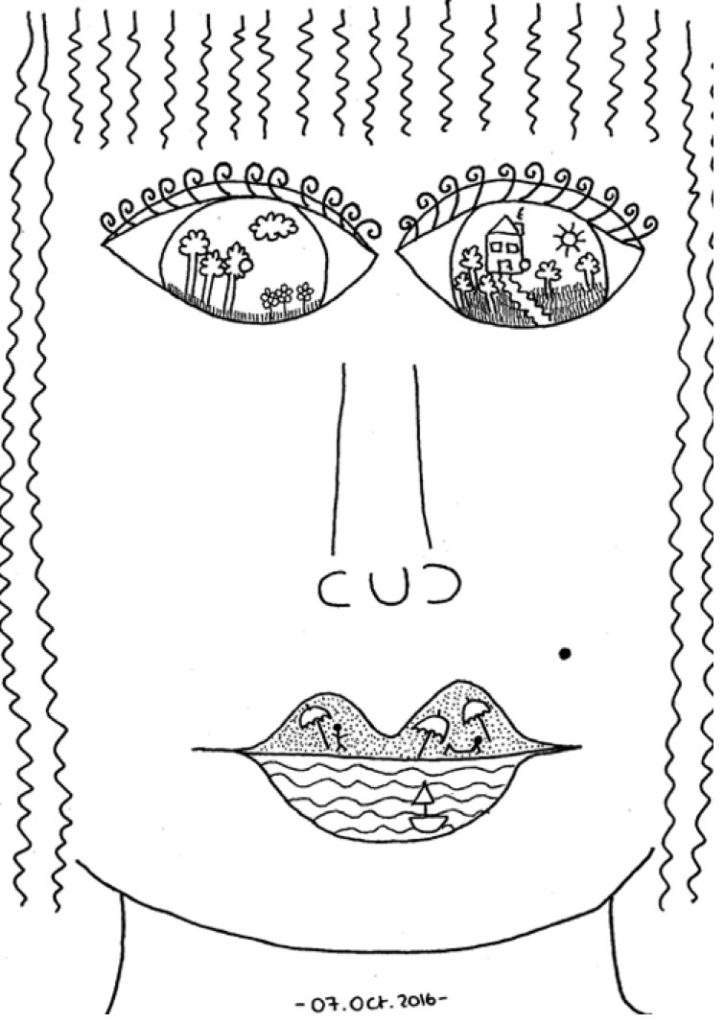Ola Abu Al-Shalashel .. About This Beautiful Anger That Left Us Quickly!

In the previous article exploring the experiences and lives of women around us who belong to a contemporary tribe of women who “run with wolves”, we were inspired by Ghada Abdel-Al’s experience and its stubborn intersection with the current flow of life.
As for this current article, we follow another Egyptian face, which led me to follow the map of anger inside me, and I did not know what I would encounter in my attempt to pull the thread, except that I met “Ola Abu Al-Shalashel.”
Who is Ola Abu Al-Shalashel? And what are her points and lines that gave me a broadening of vision and a definition of anger, despite the distance between us?
What does feminist rage mean? And why do we need to blog about our contemporary tribe, especially in the last ten years?
Are Women, in General, Angry? Where Do They Go With all This Anger?
There is a hypothesis that being a woman and living in the Near East means that you are angry some of the time.
And if you open your feminist consciousness, you get angry all the time.
There is a stereotype of feminists being hysterically angry, screaming as they march to demand violated rights.
I understand this in its context, as marches and street struggles require shouting. I also understand that screaming is itself a component of Arab culture.
We use the voice as a tool of power and control, occupying the air, imposing opinion and silencing the other if necessary. This is our common heritage that we would like to detach from in every possible way.
I remember that friend who crossed paths with me in a far away country, and told me her trick that keeps her from going crazy: “Go to a concert, melt with the crowd, and then unleash your vocal cords. Shout as much as possible. Nobody will stop you. No one will tell you that your voice is too loud. You will not be arrested, because your voice is a cacophony among the crowd, which blesses all that you hate and you know deep down that you absolutely hate it.”
The trick of my friend from the far away country was logical, and was aligned with the desire to identify, hide and vent at the same time.
Women, even in their anger, must remain within what is “allowed, acceptable, and agreed upon.”
That they not be barbaric, that their voices not pierce the ear of any kind or form of delicate authority, which would like to keep everything as it is, until God inherits the earth and what is on it.
But how can we be feminists and angry in our daily reality, when there is no square, theater, nor street to vent all this anger that is amassed in our bones!
I hate the narrow framing of the act of anger as an insult to feminists. There is a huge difference between anger and hostility.
The first is a human emotion that can serve as a compass for our connection to ourselves, which tells us that an outburst of anger means that in that fiery moment, something is being violated.
Here, anger comes as protection and guidance, so that we can adjust the course towards what restores balance to us, and the need to redraw the boundaries of what we refuse to let pass or agree to.
As for hatred and hostility, it is a destructive desire to crush the other. The existence of that desire, and the lack of awareness of it, means identification with the aggressor’s psyche.
So the individual becomes like the person who offended him, if he has power, he turns it directly towards the “fragile version of himself.”
Here the power of anger becomes coercion, hostility and destruction, because it turns into a whip within the tools of power. It strikes and kills those who do not have the same tool/right to be an equal or stop the harm.
So Where Do Women Go With all This Anger Then?
I stumble upon women around me who turn anger into a meditation practice according to Buddhist culture, which has been infiltrating contemporary velvety society for several years.
I admit I get involved with it some of the time. It’s okay, it gives me the ability I need to contemplate the pain inside me without getting involved in what’s happening in the world, which is beyond my ability to change.
I stumble upon constant calls for women to “dance.” I say to myself: “Okay, as you wish,” while an inner sarcastic voice rises: “Enough cheerfulness and fake happiness and misplaced toxic positivity.”
But, I quell it with a lot of kindness and mercy, so it is more consistent, although some people need a bubble of illusion from time to time, and that’s okay too.
While tracing the map of anger within me and the attempts to antagonize it, a book fell into my hands by a female Egyptian visual artist whose spirit sprouted from the January Revolution that I had not known before.
But, the first page made me feel like I had found something worth stopping for.
The first sentence in the book tells the reader: “This is a book I produced in one of my greatest moments of anger.”
Then the book continues in the words of its owner, Ola Abu Al-Shalashel, saying: “Sometime in 2014, in the midst of an intense fit of anger, I found with me a notebook and a black marker pen to vent my anger. I started drawing dots and lines next to each other. Then I began to visualize and draw anger. The notebook turned into painted diaries, which documented 3 and a half months. The notebook drew for itself a beginning and an end, the day it entered my life and the day I finished its pages.
Dots and Lines – Painted Memoirs – Ola Abu Shalashil 2014
That introduction brought back to my memory the book “Rage Becomes Her”, by the American writer and feminist Soraya Chemaly, especially in her important research on the relationship of women’s feelings of anger and their ability to create. The book won “Best Book of 2018” by The Washington Post, Fast Company, and Psychology Today.
She said: “There is a misconception that anger must turn into an act of destruction, vandalization and violence. In fact, such a narrow definition we can clearly see coming from a male imagination looking for the constant fight. As for what is happening in the world of women, it is that their anger is transformed into a huge energy of creativity, which expresses itself in the ability of creative women to generate art in all its forms, and not only that, but also to build participatory societies.”
Was Ola Liberating Anger and Also Spinning it Through Her Art and Life? How?
Ola: From personal anger to the general, from the general to the personal
Ola Abu Al-Shalashel talked about birthing herself in conjunction with the January 2011 revolution, saying: “On January 31, I started having dreams, which made me ask myself questions like on my own personal level, how could this change affect me? What are the things that will change that could affect me? I mean, is it possible, for example, will I walk in the street without harassment all the time, for example? This is a change. Could the police station’s procedures, for example, become more merciful? Can I get an ID issued without worrying 7,000 times and going there with it weighing so much on me?”
And she added, “If, I don’t know, all the needs that are related to my daily life, society, and the government, started jumping from time to time in my head. And I thought this is my life. But then also it didn’t make sense for me not to be part of the people, who make the change that will eventually affect me. If I want to be present, then I must be present in reality, not present in the way of “Oh, yeah I am completely with you, you just go down and I will stay here.”
Ola’s presence in the public sphere was evident through her involvement as an actor and partner in a number of societal initiatives, which shaped the depth of feminist awareness in the last 10 years, and the period of revolutionary upheaval to be precise.
She participated as a visual artist and performer, and worked as a graphic designer, web designer, illustrator, editor and translator, actress and storyteller.
She volunteered in a feminist graffiti project in Cairo in 2012, which raised questions about the extent of the emergence of the word “feminist” and the project tried to transfer these questions to the public space.
Ola has worked with “Nazra” for Feminist Studies, “Ikhtiyar” for Gender Studies, Wiki Gender, and The “Bossy” Project.
She reintroduced her anger and feminist consciousness flowing through the art of theater, through her participation as an actress and storyteller in the “Bossy” project.
It is an artistic project, aiming to create a free space for women and men in Egypt, to talk about personal experiences that are ignored in society.
Since 2006, Bossy has been documenting and presenting real stories in the form of theatrical performances, in different communities in Egypt.
Ola was not satisfied with being a performer and storyteller, but rather chose to establish another creative story, by launching and founding “Meshabbek”.
It is a local creative platform, to connect and network all Egyptian artists, through a virtual space, to easily access everything needed to complete their artwork.
This story snatched a well-deserved victory in 2012, by winning the Cairo Prize for Cultural Transformation, and it is still active today.
She also participated in documenting the sexual abuse that women were subjected to in the marches during the January 2011 revolution, through the work “The Revolution Must Be Feminist,” which was shown in 2016 between Cairo and Sweden.
And although I did not intersect with her in life, such a free and daring adventurous spirit running around despite the wolves and life with its twists and turns, can always fly across all banks.
How can she not, when she was the one who told us through one of her drawings not to stop being angry and creative at the same time, and to see that there is a possibility for another story with eyes that see the unseen?

Archive drawing – Ola Abu Al-Shalashel – 2016
September 25 was the fourth anniversary of Ola Abu Shalashel’s death. It was not celebrated by Google, nor by social media.
Perhaps it was limited to a narrow circle of friends and partners of her inspiring work during the journey of this artist who quickly left us.
It’s okay, I have the book “Dots and Lines”. On the 29th of October last, it was her birthday.
Let us rewrite our collective feminist memory, so that it does not turn into a funeral ritual.
Let us celebrate all the inspirers, and let us cross over to them with all their experience of savoring life, and their attempt to tame the anger within them.
Let us celebrate everything left by Ola Abu Al-Shalashel, who seems to have succeeded in antiquating all this anger in beautiful art, in every possible way for a wider world outside her, and whose feet, wherever they may have stepped, sprouted life.

